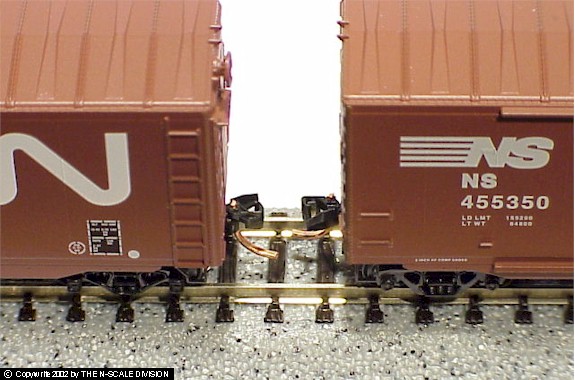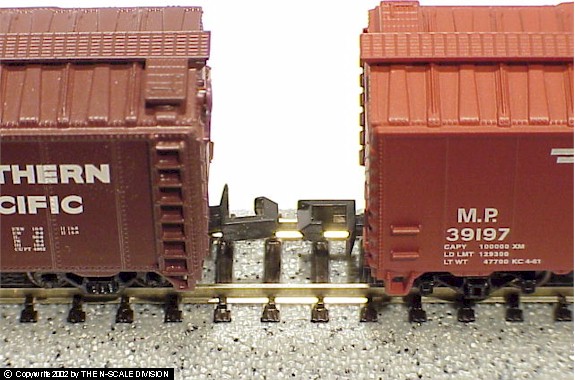There are other manufacturers, Atlas and Kato among them, who have couplings that surpass Rapido and match Micro-Trains for functionality, but which haven't achieved the same acceptance for aesthetic reasons.
On the left, courtesy of the N Scale Division web site, is an example of the Rapido style coupling, in open position.
Modelers like neither the look, nor the functionality of these couplings, which hark back to the early days of N scale modeling.
Micro-Trains couplings, now re-branded as Kadee, satisfy in both areas - they look the part (i.e. they are prototypical) and also allow advanced functionality such as delayed uncoupling (pre-coupling) which let modelers perform complex switching and shunting maneuvers.
 The image on the right, again from the N Scale Division web site, shows the Kadee/Micro-Trains couplers mounted on the same (or similar) wagons as the Rapido image above.
The image on the right, again from the N Scale Division web site, shows the Kadee/Micro-Trains couplers mounted on the same (or similar) wagons as the Rapido image above.They are known as knuckle couplers, and while they're not the only ones on the market, they have become the market leader.
So, now that we're all on the same page, what happens when you have Rapido style couplers, but you want Kadee/Micro-Trains?
In the US, there are two decisions to make - which models of Micro-Trains coupler to buy (there are several kinds) and how to actually fit them. Starting with the first, the Micro-Trains web site has a great list of all the various products that they make, and how they map to various rolling stock manufacturers.
Depending on the year, model, and whether it's a locomotive or a wagon, removing the old couplings ranges from easy (pop out) to medium (unscrew and pop out) through to hard (cut-off.) Luckily, Micro-Trains have mounting kits available that help you out if you need to go with the hard way.
These mounting kits also have little glue-on feet and come with gauges so that you can get the height exactly right (no mean feat) and they make the entire process as easy as possible.
Before you actually get out a craft knife, though, do check if you can remove the body from the chassis, and pop out the existing coupling!
In Europe, things are a little easier, as we have something called the NEM standards, which all manufacturers are supposed to adhere to. They cover everything from DCC operation, to the exact height and length of various coupling types.
Most modern rolling stock from the likes of Graham Farish has NEM pockets that can take any kind of compatible coupling on the market - Kadee/Micro-Trains included. The old couplings just pop out, and the new ones slide in.
Of course, older rolling stock, and those with proprietary moulded couplings will need to be dealt with the hard way - with a craft knife and conversion kit. But, with practice, it becomes easier. I've documented the process for OO conversions in a previous blog post.

No comments:
Post a Comment